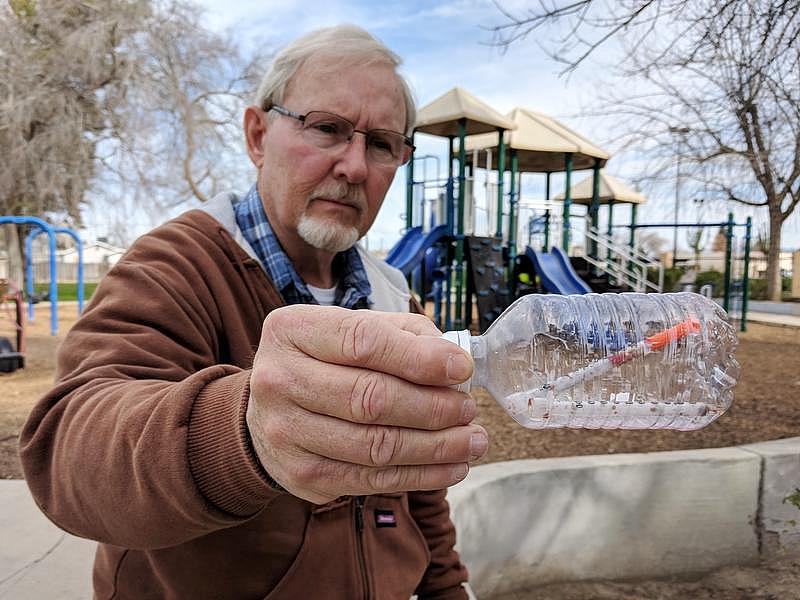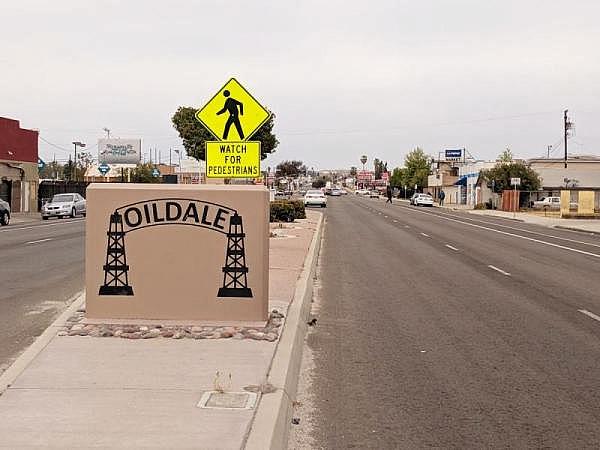It Used To Be Kern County's Opioid Epicenter, But Oildale May Be Cleaning Up
This story was produced as part of a larger project led by Kerry Klein, a participant in the USC Center for Health Journalism's 2018 Data Fellowship.
Other stories in this series include:
Kern County’s Opioid Users Lack Access To Much Needed Treatment
Four Years Sober, Recovering Heroin User Shifts Focus To Saving Other Lives
To Bakersfield Cops, Concern For Opioids Grows - But Meth Is Still King

Oildale Community Action Team director Dave Kadel stands with a hypodermic needle he found.
KERRY KLEIN / VALLEY PUBLIC RADIO
Charlie Huddleson has always been a religious man, but it was one church service in 2013 that cracked him open. “When I hit my knees on that altar, it felt like my whole life had come out my eyes,” he says. “It felt like I had cried away every pain, every heartache, and everything, and that’s the day that my life started changing.”
Huddleson was 53 at the time, and in a court-ordered drug treatment program. He’d spent the previous four decades in and out of prison, battling heroin while watching the drug consume his friends, family, and an ex-wife. “There's a great illness here,” he says. “It's opiates.”
He says he came across drugs after a broken childhood. “My father beat me so intensely when I was 6 years old he gave me brain damage, so they say,” he says. “My head swelled and almost died.”
By the age of 10, he says he was skipping school and getting into trouble. It was only a few years later, in juvenile prison, that he was exposed to the drug that would derail his life. “When you try to get off of it your brain likes being loaded,” he says. “It's just like the devil and God, one on each shoulder. You're battling with addiction and you're battling with these things that you haven't worked through.”
After trying dozens of recovery programs, the calling Huddleson felt on that altar in 2013 was the one that stuck. At 59, Huddleson just celebrated his sixth sobriety anniversary. Now, he’s helping others recover, in a county where thousands of people are hooked on heroin and pain pills and few are in treatment—numbers that don’t even take into account the county’s other rampant drug problem, methamphetamine.
For decades, if you’d asked anyone in Kern County where to score drugs, they’d tell you Oildale. And in 2015, residents there died of opioid overdoses at a higher rate than anywhere else in the county. But in 2016, those numbers plummeted to the lowest they’d been in years. In fact, Oildale’s fatal overdose rate appears to be bucking the trend, in a county where fatal overdoses have been generally increasing since 2011. Why? Some point to community advocacy, others to better access to medical treatment, but whether the improvement can last remains to be seen.
Huddleson wears a t-shirt of a verse from First Corinthians over broad shoulders and tattooed sleeves. He’s earnest, dead serious when he wants to be, but with a warm smile that spreads easily under a scraggly salt-and-pepper beard. He’s a trucker, but when he’s not on the road, he donates his time to Keepers of the Cross, a motorcycle ministry that runs a community hub on Oildale’s main drag.
Christian rock wafts out the front door of the yellow building on Chester Street, where the Keepers host sermons, health clinics, and free meals, and they’re building a women’s shelter. “We just go into the streets and we just tell people 'hey, Jesus loves you,'” Huddleson says. “We give them water, we give them food. We do all kinds of outreach in the trenches of the opiate world.”
He looks to his fellow Keepers as mentors. He says working alongside them is what keeps him clean. “When I surround myself with Keepers, pastors, parishioners from different churches, I’m held accountable,” he says.
Oildale is an unincorporated community of roughly 34,000 residents across the Kern River to the north of Bakersfield and east of state route 99. The community is roughly 85 percent white, and more than a quarter fall below the poverty level. (CREDIT KERRY KLEIN / VALLEY PUBLIC RADIO)
A few streets away, Donna Clopton picks up trash in Beardsley Park. It’s one of her regular rounds for the Oildale Prevention Partnership, which she runs when she’s not working as a security guard. “Just be careful when you're walking because you are in soft shoes,” she tells me. “Watch for needles.”
Sure enough, within five minutes, we find two syringes. One’s in the wood chips underneath a jungle gym, with blood in it. The other, in a garden bed, is missing the needle. “I don't know if they're hiding them so that they can come back and reuse them or if it's just their way of disposing of them,” Clopton says. She drops them in a plastic bottle to dispose of later.
Alongside her, Dave Kadel rakes his feet through wood chips. “Just to make sure there's nothing here that's going to be a hazard for the kids,” he says. He’s wearing thick sneakers.
Kadel is a retired sheriff’s deputy and director of the Oildale Community Action Team. He says drugs are the root of so many of Oildale’s problems. Take crime, he says: Imagine how much stuff users have to steal to sustain their habit. “Typically it's going to be probably ten cents on the dollar,” he says. “So, your thousand dollar TV that they stole from you? They're going to get $100 worth of drugs from that. That's not going to help them for more than about 12 hours.”
It’s no wonder bars line the windows of Oildale businesses. The Walmart on Chester Street locks up even its cheap merchandise, like toothbrushes and nail polish.
An associate pastor in Oildale, Kadel is mild-mannered and chatty. He used to be a music minister. Donna Clopton, herself recovering from cocaine addiction, keeps granola bars and blankets in her car for the homeless people she encounters. Their organizations help struggling community members access housing, healthcare, and services. In other words, they treat them like people. “You’ve got to have some compassion for these people. They have value," says Kadel. "This guy sleeping over there under the tree, he's somebody's son, daughter, brother, sister, you know.”
As of a few years ago, those struggling with opioids have easier access to treatment. Fatal overdoses dropped in Oildale in 2016, just after a new clinic opened across the river in Northern Bakersfield. It’s run by Aegis Treatment Centers, a statewide network of medication-assisted treatment centers offering methadone and buprenorphine (also known as suboxone). Research has shown that these drugs are more successful in recovery than quitting cold turkey, and in some studies they’ve reduced overdose death rates by as much as 75 percent.
Regional Director Javier Moreno says the clinic opened its doors in late 2015, 20 years after another began operating on 21st Street. “We noticed that our 21st Street location was seeing a huge increase in patients from the northern part of Bakersfield,” Moreno says. “So it only made sense to open up a treatment center closest to that pocket of patients.”
He says about a third of this clinic’s 350 patients come from Oildale. Indeed, the community’s prescriptions of methadone and buprenorphine have soared since 2015.
Moreno sits in a room used for art therapy. Post-Its written with patients’ goals cover the door: “Being free from addiction"; “never having to use pills again": “a family for my son.” Moreno mentions a long-time patient he just ran into, who told him he’d recently graduated from college and gotten a job. “We get to hear these stories on a daily basis and for us it's a daily reminder that what we're doing works.”
Simultaneously, however, Oildale’s emergency room visits due to opioids have been increasing. Moreno offers one hypothesis why. “It’s pretty evident what's happening right now is that providers are fearful to write scripts and they're just leaving patients to fend on their own,” he says, which can push those addicted to pain pills toward street drugs like heroin and the super-concentrated fentanyl.
So is Oildale’s opioid problem getting better or worse? “I just think it’s too close to make that determination,” says Ann Sherwood, a program coordinator who oversees drug prevention with the county’s behavioral health department. She herself grew up in Oildale, at a time when she says kids were proud to call it their home.
Today, she says too many variables are up in the air, like drugs coming in from China, and fentanyl, which hasn’t yet clobbered California the way it has the East Coast. But she does feel community groups in Oildale are particularly well coordinated. “I think they’ve figured out how to have their voice be heard and how to utilize their resources for their benefit,” she says.
“Do I feel like I'm making a difference?” asks Charlie Huddleson, of Keepers of the Cross. “I believe my part in it is making a difference, yeah. I believe that we reach a lot of people.”
But he can’t reach everyone. Three of his six siblings have died of heroin overdoses. His last surviving brother, who lives on the streets, is also a heroin user. Huddleson carries a change of clothes and pair of shoes for the next time he sees him. “You’ve just got to love them until they love themselves,” he says. “I think that's the basis of beating addiction, is loving yourself.”
The next question is: Will the rest of Oildale love itself?
[This story was originally published by the Valley Public Radio.]

